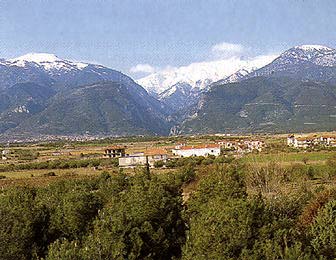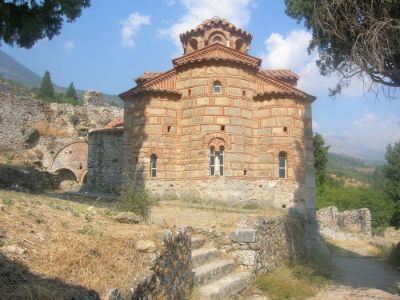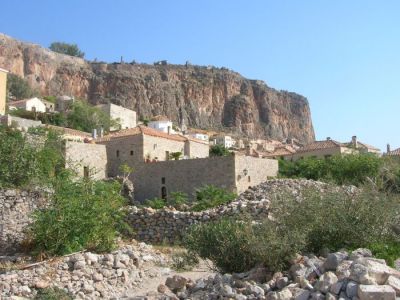|
|
Lakonia
 Sparta: (11,911
inhab.) is notorious in ancient history for the austerity of its regime,
but it is now a provincial town with parks, broad avenues and a pleasant
atmosphere. The ride from Argos to Sparta (through Tripoli) is something
else. Hairpin turns in the Kleisoura Pass and great views make it worth
your while as long as your not driving. The modern town of Sparta (est.
1834) is a little south of the ancient one, of which there is very little
left. It sits below Mount Taygetos and is described by Strabo.
I didn't make it out to the archaeological
museum of Sparta, but they do have a collection there with some pottery,
mosaics, and sculpture. The archaeological site (on the bus in, after
passing over the Eurotas River, you'll veer to the left and then back to the
right, thereby avoiding the edge of the Acropolis), is reached via a
beautiful tree-lined road just north of the modern town. The Acropolis
of Sparta is not what you might expect, though there the remains of a Roman
theater. If you do visit, note the drawings of the ancient stage in
the Blue Guide, the scene would be decorated and rolled on metal rods out of
a shed adjacent to the theater. Also in Sparta, you can find the Sanctuary
of Artemis Orthia and (just south of town) the Menelaion.
If you're interested you can find most of the course of the city walls, which
were only needed after the ancient city began its decline.
Sparta: (11,911
inhab.) is notorious in ancient history for the austerity of its regime,
but it is now a provincial town with parks, broad avenues and a pleasant
atmosphere. The ride from Argos to Sparta (through Tripoli) is something
else. Hairpin turns in the Kleisoura Pass and great views make it worth
your while as long as your not driving. The modern town of Sparta (est.
1834) is a little south of the ancient one, of which there is very little
left. It sits below Mount Taygetos and is described by Strabo.
I didn't make it out to the archaeological
museum of Sparta, but they do have a collection there with some pottery,
mosaics, and sculpture. The archaeological site (on the bus in, after
passing over the Eurotas River, you'll veer to the left and then back to the
right, thereby avoiding the edge of the Acropolis), is reached via a
beautiful tree-lined road just north of the modern town. The Acropolis
of Sparta is not what you might expect, though there the remains of a Roman
theater. If you do visit, note the drawings of the ancient stage in
the Blue Guide, the scene would be decorated and rolled on metal rods out of
a shed adjacent to the theater. Also in Sparta, you can find the Sanctuary
of Artemis Orthia and (just south of town) the Menelaion.
If you're interested you can find most of the course of the city walls, which
were only needed after the ancient city began its decline.
 Mistras: A few miles to the west is the monastery town of Mistras (now
only a few buildings are still used) from the middle ages.
Founded in 1249 A.D., the main castle was an attempt to give
the Franks a good position with which they could control the
local Greeks. They soon were forced to give the site to
the Greeks and then the Byzantine State of Mistras thrived
until modern Sparta was repopulated in the 19th century.
It is quite large and the last emperor of Byzantium was even
crowned here. Mistras
is worth the visit if you are in the neighborhood. The
site was also designated a World
Heritage Site by UNESCO in 1989. They also have a
small, but cramped, Archaeological
Museum of Mistras. The biggest structure, the Palace of
Despots (pictured here), was being roofed while I was there
and once covered it might make an excellent museum.
Mistras: A few miles to the west is the monastery town of Mistras (now
only a few buildings are still used) from the middle ages.
Founded in 1249 A.D., the main castle was an attempt to give
the Franks a good position with which they could control the
local Greeks. They soon were forced to give the site to
the Greeks and then the Byzantine State of Mistras thrived
until modern Sparta was repopulated in the 19th century.
It is quite large and the last emperor of Byzantium was even
crowned here. Mistras
is worth the visit if you are in the neighborhood. The
site was also designated a World
Heritage Site by UNESCO in 1989. They also have a
small, but cramped, Archaeological
Museum of Mistras. The biggest structure, the Palace of
Despots (pictured here), was being roofed while I was there
and once covered it might make an excellent museum.
The
mountains around Sparta (really just on the west) are amazing
when you are first arriving. The site of Mistras is located
near the bottom of their eastern slope. Most spectacular
is Mount Taygetos. They also prove no small
feat in getting over them. The area from Sparta to
Kalamata is one of the most desolate stretches of road in the
Peloponnese, reaching some extremely high peaks along the way.
The Langadha Pass is no easy feat to cross even on clear days
and should be approached with care in inclement weather.
 Monemvasia:
Connected
to the mainland Peloponnese by a narrow causeway, the Rock of
Monemvasia is home to a beautiful medieval village on the
lower slopes and an ancient, ruined, fortress hilltop town.
Entrance to the inhabited part of the rock is made through the
village gate that leads to a narrow, cobbled thoroughfare that
is the main artery of the village. Lined with quaint shops,
bars and tavernas, some of which have wonderful sea-facing
terraces, the absence of all motorised transport is a blessing
with donkeys the only means of transport. A steep track leads
to the rock's summit and the ruins of the ancient fortress
including the church of Aghia Sophia containing a few but
impressive wall paintings. Monemvasia:
Connected
to the mainland Peloponnese by a narrow causeway, the Rock of
Monemvasia is home to a beautiful medieval village on the
lower slopes and an ancient, ruined, fortress hilltop town.
Entrance to the inhabited part of the rock is made through the
village gate that leads to a narrow, cobbled thoroughfare that
is the main artery of the village. Lined with quaint shops,
bars and tavernas, some of which have wonderful sea-facing
terraces, the absence of all motorised transport is a blessing
with donkeys the only means of transport. A steep track leads
to the rock's summit and the ruins of the ancient fortress
including the church of Aghia Sophia containing a few but
impressive wall paintings.
The mainland
town of Nea Monemvasia or Gefira as it is sometimes known, has
an attractive harbour with plenty of tavernas and cafes. The
pebble beach is not remarkable but the town is the perfect
base to explore further afield in the southern Peloponnese.
Gythion, in south of Sparta, the port of is a good starting point for
exploring the Mani area. There are caves with underground
lakes and rivers at Glifada and Alepotripa in the Diros
region. |